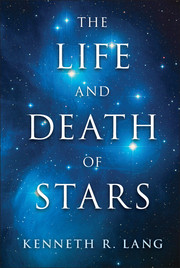Book contents
- Frontmatter
- Contents
- List of Focus Elements
- List of Tables
- Preface
- 1 Light of the Sun
- 2 Gravity and Motion
- 3 Atomic and Subatomic Particles
- 4 Transmutation of the Elements
- 5 What Makes the Sun Shine?
- 6 The Extended Solar Atmosphere
- 7 Comparisons of the Sun with Other Stars
- 8 The Lives of Stars
- 9 The Material Between the Stars
- 10 New Stars Arise from the Darkness
- 11 Stellar End States
- 12 A Larger, Expanding Universe
- 13 Birth, Life, and Death of the Universe
- Quotation References
- Author Index
- Subject Index
- Plate section
10 - New Stars Arise from the Darkness
Published online by Cambridge University Press: 05 February 2013
- Frontmatter
- Contents
- List of Focus Elements
- List of Tables
- Preface
- 1 Light of the Sun
- 2 Gravity and Motion
- 3 Atomic and Subatomic Particles
- 4 Transmutation of the Elements
- 5 What Makes the Sun Shine?
- 6 The Extended Solar Atmosphere
- 7 Comparisons of the Sun with Other Stars
- 8 The Lives of Stars
- 9 The Material Between the Stars
- 10 New Stars Arise from the Darkness
- 11 Stellar End States
- 12 A Larger, Expanding Universe
- 13 Birth, Life, and Death of the Universe
- Quotation References
- Author Index
- Subject Index
- Plate section
Summary
How the Solar System Came into Being
The Nebular Theory
Where did the Sun and its attendant planets come from? How and when did they form? The most likely explanation is provided by the nebular theory, which states that the Sun and planets formed together as a result of the gravitational collapse of an interstellar cloud of gas and dust – also known as the solar nebula, Latin for “cloud” (Fig. 10.1). This theory accounts for the orderly, aligned motions of the major planets. They all move in a narrow band across the sky, implying that their orbits all lie in nearly the same plane, which nearly coincides with the Sun's equatorial plane. All of the planets move in the same direction within their Sun-centered orbits, and both the Sun and most of the major planets rotate in this direction – Venus and Uranus are the exceptions.
The orbits of most of the planetary moons, or satellites, imitate those of the planets in being confined to the planet's equatorial plane and revolving about the planet in the same direction that the planet rotates.
This regular orbital arrangement of the solar system is not accidental. Even if 1 million million million, or 1018, solar systems were made haphazardly and the planets and moons were thrown into randomly oriented orbits, only one of these solar systems would be expected to look like our own. So, it is exceedingly unlikely that the planets became aligned by chance.
Although Newton’s laws and Kepler’s laws describe the present motions of the solar system, they cannot explain the remarkable arrangement of its planets and satellites. Additional constraints are required, which describe the scenario before the planets were formed and set in motion. These initial conditions are provided by the nebular hypothesis, the basic idea of which was introduced in the mid-eighteenth century by the German philosopher Immanuel Kant in his book, Allgemeine Naturgeschichte und Theorie des Himmels (Universal Natural History and the Theory of the Heavens). Kant pictured an early universe filled with thin gas that collected into dense, rotating gaseous clumps. One of these primordial concentrations was the solar nebula.
- Type
- Chapter
- Information
- The Life and Death of Stars , pp. 201 - 218Publisher: Cambridge University PressPrint publication year: 2013



